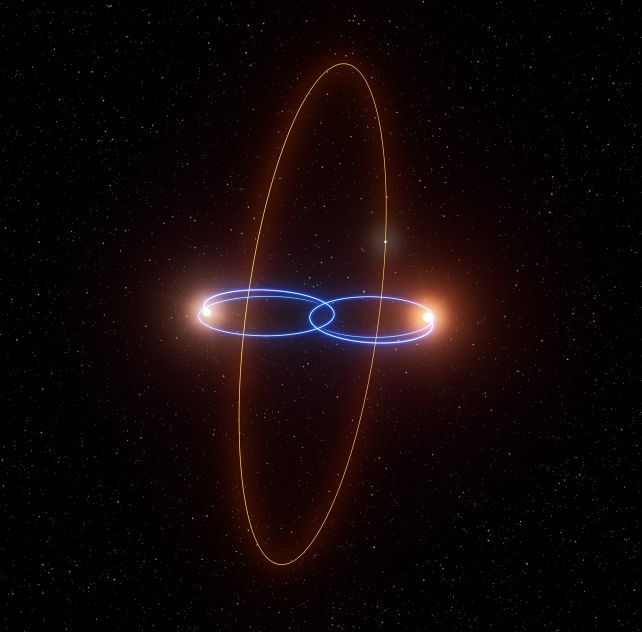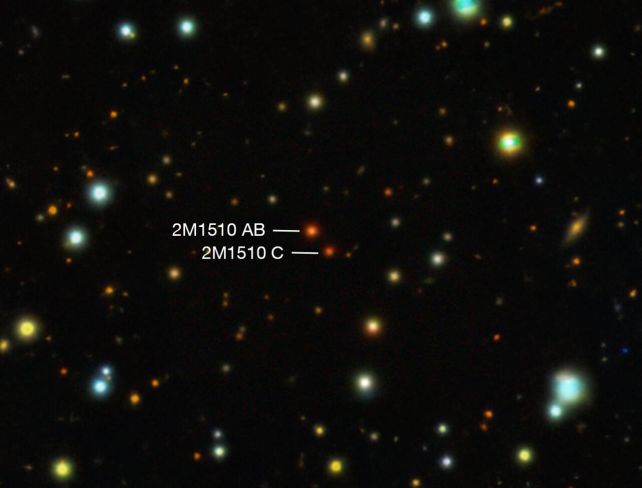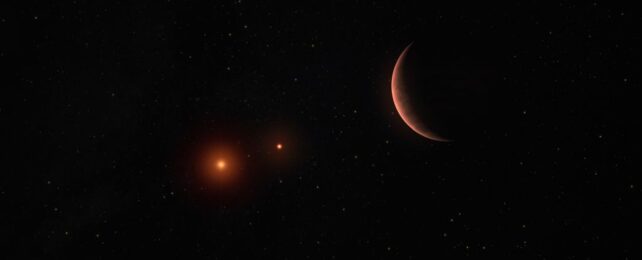A collection of objects just 120 light-years away is a truly gob-smacking, one-of-a-kind system.
It consists of two brown dwarfs locked in a configuration known as an eclipsing binary, with a smaller exoplanet in its own orbit around both. What makes the system even more special is that the exoplanet orbits on a perpendicular plane, around the brown dwarfs' poles.
It's the first time an exoplanet has been discovered on a polar orbit around any binary system, never mind an eclipsing pair of brown dwarfs. The system, called 2M1510, represents only the second eclipsing brown dwarf binary ever discovered.
"A planet orbiting not just a binary, but a binary brown dwarf, as well as being on a polar orbit is rather incredible and exciting," says astronomer Amaury Triaud of the University of Birmingham in the UK.
Brown dwarfs are odd little things ('little' being relative). They occupy the weird in-between mass regime between stars and planets. Their lower mass limit is around 13 Jupiters, heavy enough for core fusion to kick off, but not heavy enough for the hydrogen fusion we see in the cores of full stars.
Rather, they fuse deuterium, or heavy hydrogen. That's an isotope of hydrogen with a proton and a neutron instead of just a proton; it's therefore heavier than normal hydrogen, and requires less heat and pressure to fuse.
For baby stars, deuterium fusion is just a step on their journey as they continue to accumulate mass; brown dwarfs form the same way stars do, but stop growing before they get enough mass for hydrogen fusion. For that reason, they are sometimes known as 'failed' stars, but it's probably more accurate to think of them as one end of the star spectrum.
Brown dwarfs offer insights into star and planetary formation that we might not be able to obtain from stars or planets… which is partly why this new discovery is so fascinating.

The discovery was made in a pretty unconventional way, actually.
Led by astronomer Thomas Baycroft of the University of Birmingham, a team was carefully analyzing the light from the brown dwarf binary to characterize the physical and orbital properties of the two objects when they noticed something strange. The motion of the stars could not be entirely explained by their orbit around each other.
Now, stars are not fixed in space. They can be gravitationally influenced even by much smaller bodies; so a star with an orbiting exoplanet will be gravitationally tugged, just a little bit, causing it to 'wobble' a little on the spot in a way that minutely changes the wavelength of its light.
Astronomers, including Triaud, have made strides in the last few years in detecting planets in multi-star systems by carefully looking for these wobbles in the stellar orbits – so when a little glitch showed up in the light from 2M1510, they were primed to find the answer.

A careful study of the system revealed a third brown dwarf at a much greater distance – too far to be the source of the wobble in 2M1510. The team conducted some modeling, and found a surprising answer.
"We reviewed all possible scenarios, and the only one consistent with the data is if a planet is on a polar orbit about this binary," says Baycroft.
According to their measurements, the two brown dwarfs – 2M1510 A and 2M1510 B – each have a mass around 35 times that of Jupiter. They have a relatively close orbit with a period of just 20.9 days. An eclipsing binary means that they pass in front of each other on their orbital path, from Earth's perspective.
The third brown dwarf, 2M1510 C, is at a much greater distance, some 250 times the distance between Earth and the Sun, with a period of about 11,000 years.
The properties of the exoplanet, called 2M1510 (AB) b, are a little difficult to ascertain, so that has been left vague for now. There are ranges between 100 and several thousand days for the orbital period, and 10 and 1,000 Earth masses for the mass, with the most likely range somewhere in the hundreds of Earth masses (Jupiter is about 318 Earth masses).
The team plans to conduct follow-up observations in greater detail to narrow down this rather large uncertainty, and figure out what the heck is going on with 2M1510. But, even in vague terms, the discovery is wildly exciting.
"The discovery was serendipitous, in the sense that our observations were not collected to seek such a planet, or orbital configuration. As such, it is a big surprise," Triaud says. "Overall, I think this shows to us astronomers, but also to the public at large, what is possible in the fascinating Universe we inhabit."
The research has been published in Science Advances.
